How to Stop Microphone from Auto Adjusting Windows?
Several users have been reaching us with questions after being increasingly annoyed by the fact that their microphone is automatically adjusting without any user intervention. Most affected users are reporting that the microphone levels either go up or down, with no apparent trigger. The issue is reported to occur with multiple applications (built-in or 3rd party).

What is causing the Microphone Levels to Auto-Adjust on Windows 10?
We investigated this particular issue by looking at various user reports and the repair strategies that are commonly being used to resolve this particular issue on Windows 10. As it turns out, there are several different culprits that have the potential of producing this problem:
- Skype is automatically adjusting the microphone – If Skype (UWP or desktop version) is configured to launch at every system startup, chances are that’s you’re the culprit responsible for the automatic microphone adjustments. In this case, you should be able to resolve the issue by disabling the automatic microphone adjustment settings.
- Steam is automatically adjusting the microphone – Just like Skype, Steam is also capable of automatically adjusting the microphone if it’s configured to be launched at every system startup. If this scenario is applicable to your situation, you should be able to resolve the issue by accessing the Friends List settings and disabling Automatic Volume/gain control.
- An application takes exclusive control of the microphone – Another possibility is a different application that is allowed to take exclusive control to the recording device and adjust it’s level automatically. In this case, you should be able to resolve the issue by disabling exclusive mode or by booting in clean mode to identify the culprit.
- Microphone level is not manually adjusted – Windows includes a toggle that should allow you to override any application that might be adjusting the microphone level automatically. Several affected users have reported that using this procedure allowed them to resolve the issue indefinitely.
- Outdated or corrupted microphone driver – An improper driver can also be responsible for this particular microphone problem. As it turns out, an outdated driver has the potential of triggering this behavior (the same goes for a corrupted driver). In this case, you should be able to resolve the issue replacing the current microphone driver with the latest version available.
- Malware infection – THis particular issue can also be caused by a malware capable of shutting down the microphone or adjusting the level to a maximum level at all times. Several affected users have reported that they managed to find the virus and deal with it by performing a Malwarebytes scan.
If you’re currently struggling to resolve this error, this article will provide you with several different troubleshooting steps. Down below, you’ll find a collection of methods that other users in a similar scenario have successfully used to resolve the microphone issue on Windows 10. Each of the potential fixes featured below is confirmed to be effective by at least one affected user.
For the best results, we advise you to follow the methods in the order that they are presented since we ordered them by efficiency and severity. One of them is bound to resolve the issue regardless of the culprit that’s causing it.
1. Preventing Skype from automatically adjusting the microphone (if applicable)
If you have the habit of keeping Skype open most of the time, chance are the VoIP client is actually adjusting your microphone levels without telling you. As it turns out, Skype is configured by default to be allowed to modify the volume of your connected microphones. This happens with both the desktop and the UWP version of Skype.
Several affected users have reported that they managed to resolve the issue indefinitely by accessing Skype’s settings and disabling the client’s ability to adjust the microphone level’s. Here’s a quick guide on how to do this:
- Open Skype UWP and click the action button (top-left section of the screen) and click on the action button (three-dot icon). Then, from the context menu, click on Settings.

Accessing the settings menu of Skype Note: If you’re using the desktop version of Skype, use the ribbon bar at the top to go to Tools > Options.
- Once you’re inside the Settings tab, select the Audio & Video tab from the vertical menu on the left.
- Inside the Audio & Video tab, scroll down to the Microphone section (under Audio) and uncheck the box associated with Automatically adjust microphone settings.
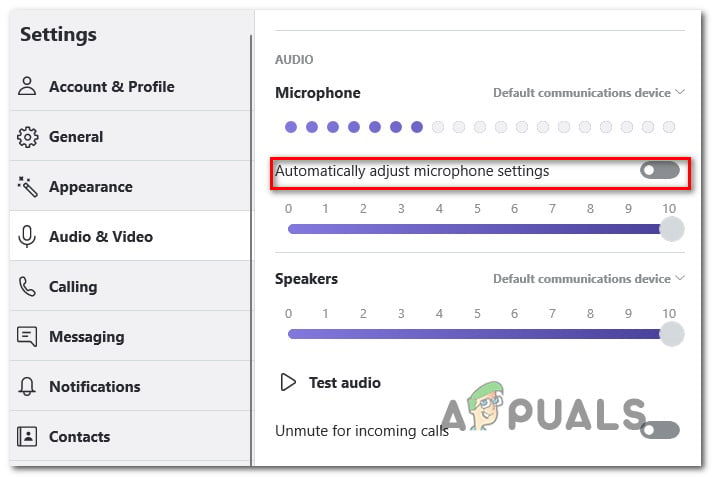
Preventing Skype from adjusting the microphone Note: If you’re using the desktop version of Skype, go to Audio Settings and uncheck Automatically adjust microphone settings.
- Use your computer normally and see if you’re still encountering the auto microphone adjustments. If the same issue is still occurring, move down to the next method below.
2. Preventing Steam from automatically adjusting the microphone level (if applicable)
As it turns out, Steam is yet another application that might be causing automatic microphone level adjustments on a Windows 10 computer. If you have Steam installed and it’s configured to launch automatically at every system startup, chances are it has the capabilities to make microphone level adjustments.
Several affected users have reported that they managed to resolve the issue by accessing the Friend List’s settings of the Steam client and disabling the Automatic volume/gain control setting from the Automatic Settings menu.
Here’s a quick guide on preventing Steam from automatically adjusting the microphone level via the Friend’s list window:
- Open the Steam client, log in with your account and click on the Friends & Chat icon in the bottom-right corner of the screen.
- Inside the Friends & Chat window, click on the gear icon located in the top-right corner of the screen to access the Settings menu.
- Once you’re inside the Friends List Settings, click on the Voice tab from the vertical menu on the left, then move over to the right pane, scroll down to the bottom of the screen and click on Show Advanced Settings.
- From the Advanced settings menu of the Voice tab, disable the toggle associated with Automatic volume/gain control.
- Restart Steam and see if the automatic volume adjustments are still occurring.
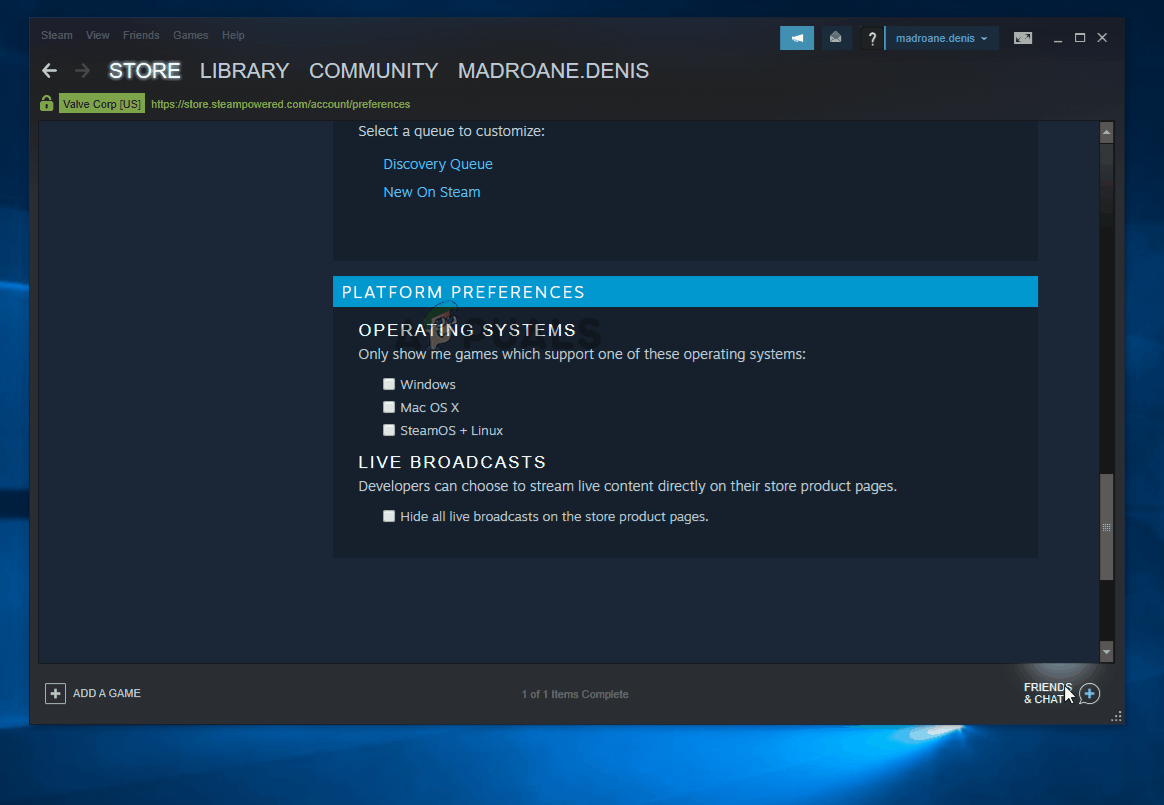
If this method wasn’t applicable to your current situation, move down to the next method below.
3. Preventing applications from taking exclusive control of the Microphone
Several affected users have reported that they managed to resolve the issue after re-configuring the MIcrophone settings so that no application is allowed to take exclusive control of the device. This procedure is quite easy to replicate and is effectively disables any type of 3rd party intervention that might cause the automatic microphone level adjustments.
But keep in mind that this procedure might also cause some voice features to stop functioning as intended. Just keep this in mind before implementing this, and in case some functionality is affected, reverse engineer the procedure below:
- Press Windows key + R to open up a Run dialog box. Then, type ” mmsys.cpl” inside the text box and press Enter to open up the Sound window.
- Once you’re inside the Sound window, select the recording tab from the horizontal menu. Then, select the microphone that you’re having issues with, and click on Properties.
- When you’re inside the Properties menu of the recording device, select the Advanced tab, then go to the Exclusive Mode section and uncheck the box associated with Allow applications to take exclusive control of this device.
- Click Apply to save the changes, then restart your computer and see if the issue has been resolved at the next system startup.

If the issue is still not resolved, move down to the next method below.
4. Modifying the Microphone Value Manually
If you’re looking for a quick fix, you can probably override whatever is automatically adjusting your microphone level by setting a default value for your microphone level via Control Panel. As reported by several users, this procedure has the potential of overriding a lot of level changes that are triggered by 3rd party applications.
But keep in mind that this procedure will not allow you to pinpoint the real cause of the issue and will override any microphone level previously established by most 3rd party applications.
Here’s a quick guide on modifying the microphone value manually to fix the auto adjustment of the microphone on Windows 10 :
- Press Windows key + R to open up a Run dialog box. Then, type “control” inside the text box and press Enter to open up the classic Control Panel interface.
- Once you’re inside the classic Control Panel interface, use the search function in the top-right corner of the screen to search for ‘sound’.
- Then, click on Sound from the list of results.
- When you’re inside the Sound window, select the Recording tab, select the microphone/headset that is currently active and clicks on the Properties button.
- Once you’re inside the Properties of the recording device that you’ve selected at step 4, go to the Levels tab and adjust the value of your microphone level using the slider. Click Apply to save the modification.
- This should ensure that the microphone value remains the same regardless of what the 3rd party program tries to modify it in the future.

If this procedure wasn’t applicable to your current situation or you’re looking for a different approach, move down to the next method below.
5. Updating your Microphone Driver
Your microphone drivers can also be responsible for levels inconsistencies. You might also be able to resolve the issue by updating your microphone drivers or by uninstalling the current driver, forcing Windows to install a new driver of your recording device.
Several affected users have reported that this procedure resolved the issue indefinitely for them. Here’s a quick guide on using Device Manager to update your microphone driver:
- Press Windows key + R to open up a Run dialog box. Then, type “devmgmt.msc” inside the text box and press Enter to open up Device Manager.
- Once you’re inside Device Manager, scroll through the list of available devices and expand the tab associated with Sound, video and game controllers.
- Right-click on the recording device that you’re having issues with and choose Properties from the context menu.
- When you’re inside the properties screen of your recording device, select the Driver tab and start by clicking on Update Driver.
- Then, from the next screen, click on Search automatically for updated driver software and wait to see if the utility manages to find a new driver version for the driver.
- Once the procedure is complete, restart your computer and see if the automatic microphone level adjustments are still occurring. If they are or Device Manager has been unable to find an updated version of the driver, continue with the steps below.
- Follow step 1 to 3 again to return to the Driver tab of your Recording device, but this time click on Uninstall Device instead of Update Driver. Then, click Uninstall once again at the confirmation prompt and wait for the procedure to complete.
- Once the recording driver is uninstalled, restart your computer to allow Windows Update to install a clean driver instead of the one you’ve just uninstalled.
- When the startup sequence is complete, see if the microphone auto adjustments are still happening.
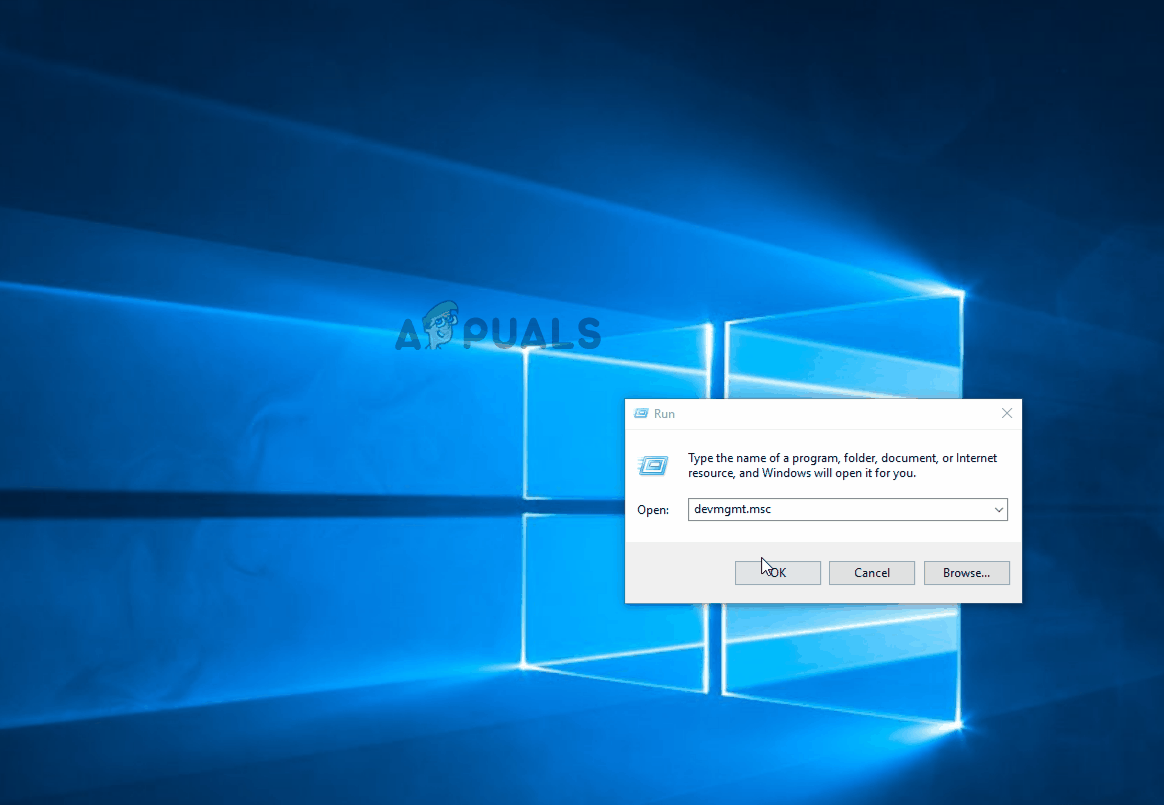
If you’re still encountering the same issue, move down to the next method below.
6. Removing the Malware Infection
As it turns out, this particular issue can also be caused by malware that is capable of shutting the mic or adjusting the level automatically. Several affected users have reported that Windows Defender and a few other 3rd party clients didn’t manage to discover the malware when they performed a security scan.
However, most users that encountered this issue have reported that they managed to identify and isolate and quarantine the malware by using Malwarebytes. In most cases, the malware made it’s way to the system from a catcher application or extension. If you think the issue might be caused by malware, follow this article (here) for steps on installing and performing a deep scan with Malwarebytes.
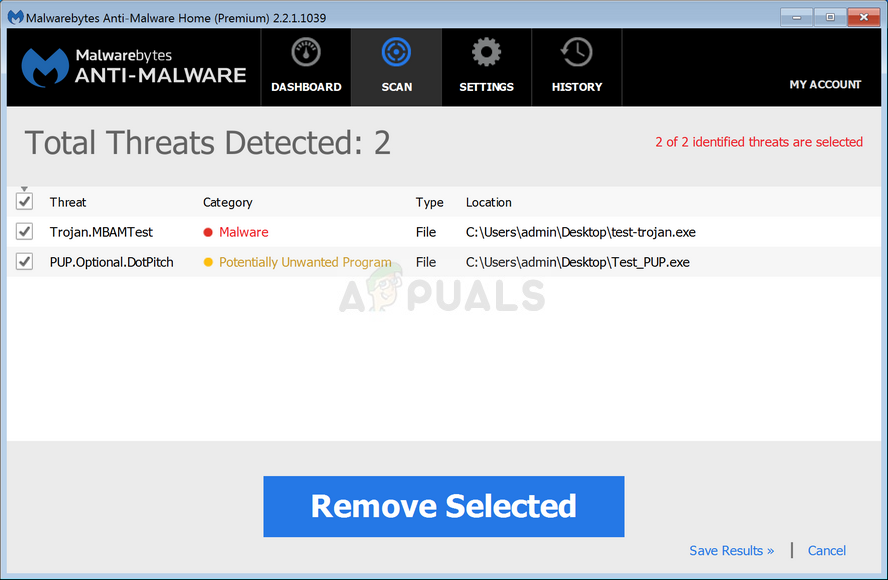
If the virus scan hasn’t revealed any evidence of a virus infection, move down to the next methods below.
7. Performing a Clean Boot
If you’ve come this far without a result, it’s possible that the issue is being caused by a 3rd party application that has admin access. If the culprit is not apparent to you, you can verify whether a 3rd party app is causing the problem by performing a clean boot.
Several affected users have confirmed that this procedure allowed them to confirm that the issue was being caused by a 3rd party app intervention. Once they managed to confirm that an application was causing the automatic microphone adjustments, they eliminated all potential culprits until they managed to isolate the application that was producing the error.
Here’s a quick guide on how to perform a clean boot in order to determine which application is causing the automatic microphone adjustments:
- First, start by ensuring that you’re using a Windows account that has administrative privileges.
- Then, press Windows key + R to open up a Run dialog box. Inside the text box of the Run command, type “msconfig” and press Enter to open up the System Configuration window. When you’re prompted by the UAC (User Account Control), click Yes to grant administrative privileges to the System Configuration window.

Running MSCONFIG from a Run dialog box - Once you manage to get inside the System Configuration window, select the Services tab from the ribbon bar at the top and start by checking the box associated with Hide all Microsoft services. Once you’ve down that, turn your attention to the remaining services. Click the Disable all button to prevent any 3rd party services from interfering with the microphone levels at the next startup.

Disabling all Windows services - Click Apply Changes, then select the Startup tab and click on Open Task Manager.
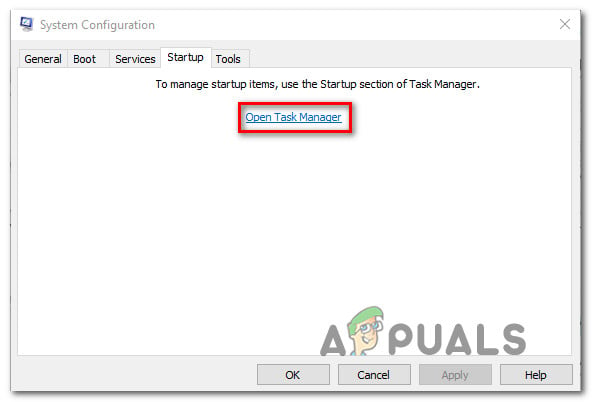
Opening the Task Manager via System Configuration - Once you’re inside the Startup tab of Task Manager, select each service individually and hit Disable to prevent it from running at the next system startup.

Disabling Apps from Startup - Once all necessary items and services have been disabled, close the Task Manager window you’ve just opened and restarted your computer to boot up into a Clean Boot State.
- Once the next startup sequence is complete, use your computer normally and see if you’re still noticing automatic microphone adjustments. If you aren’t, follow steps 3 to 5 and systematically re-enable all startup items & services that you disabled and reboot to see which one of them is causing the error.
- When you manage to identify the culprit, ensure that it remains disabled.
8. Disabling Microphone Enhancements
The Microphone audio enhancements can also be a problem in some cases, it’s possible that your Microphone is self-leveling itself because of these Enhancements, Follow these steps to disable the Audio Enhancements from your Microphone:-
- Press and hold the Windows key then press the R key to open the Run program.
- Now type “mmsys.cpl”, then press enter.

Opening Microphone Properties - Now head over to the “Recording” tab, then right-click on your Microphone and click “Properties”.

Opening the Microphone properties - Click on the “Enhancements” tab in your Microphone Properties.
- Make sure to check the “Disable all enhancements option”.
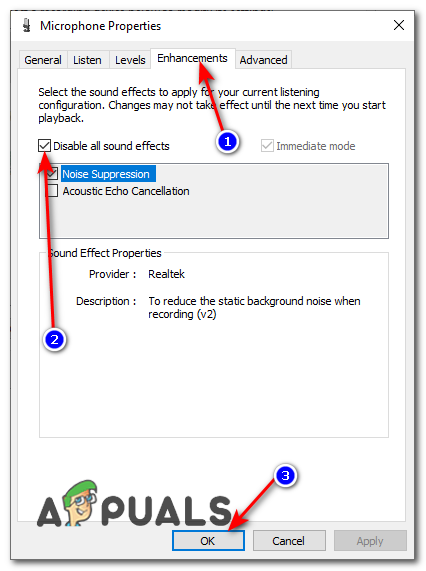
Disabling all microphone enhancements
9. Registry Fix
Sometimes, the issue lies with the registry configuration of the microphone level. Windows might have stored a value in the registry for your Microphone level which might receive precedence over the manual value that you select from the Sound Control Panel. You can adjust this value by:
- Press “Windows” + “R” to open the run prompt, type in “Regedit” and press “enter”.

regedit.exe - Navigate to the following location.
HKEY_CURRENT_USER\Software\Microsoft\Speech\RecoProfiles\Tokens\{95CF724E-B3B5-4D94-A4FB-36AE77A88FE0}\{DAC9F469-0C67-4643-9258-87EC128C5941}\Volume - Double click on the following value.
HKEY_LOCAL_MACHINE\SOFTWARE\Microsoft\Speech\AudioInput\TokenEnums\MMAudioIn\{0.0.1.00000000}.{e4e24557-c9f8-46f6-8486-50981fcf3cc5} - Set its value to the Microphone level that you want. For Example, 8888 for 88% and 2222 for 22%.
- Check to see if the issue persists.




